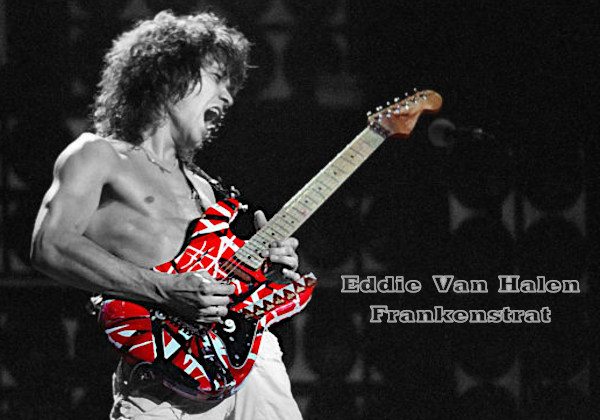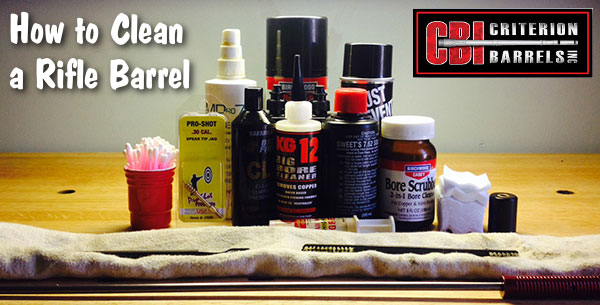Sunday GunDay: Rock’N Roll Rifle — Gavin’s Van Halen Tribute

Today’s feature story showcases an impressive 6.5×47 Lapua benchrest rifle crafted by Gavin Gear of UltimateReloader.com. A gifted writer, video producer, and gear reviewer, Gavin has also acquired some serious gunsmithing skills over the past few years.
For this project, the multi-talented Mr. Gear did ALL the work himself — barrel chambering, muzzle crowning, stock inletting, action bedding, and yes even the stock painting. That brilliant red design with white and black stripes is an “homage” to the famous “Frankenstrat” guitar played by Rock N’ Roll legend Eddie Van Halen (EVH). That red/white/black guitar was the inspiration for this tribute rifle.

Gavin explained: “I decided to build a benchrest rifle as a tribute to Eddie Van Halen as I’ve been inspired by his guitar playing, his energy, and himself as a person. This is my first benchrest rifle build. And when I set out to build this rifle I was looking around at what other people were doing in the benchrest community in terms of stock graphics, and I decided I needed to do something ‘loud and crazy’ and when I thought about that, the first thing that came to mind was Eddie Van Halen’s iconic Frankenstrat guitar.”

Here it is! My first all-out benchrest build! This rifle will serve as a test bed for the evaluation of different cartridges and components. In this multi-part series, I’ll walk through the … process of building this rifle including the barrel work, stock inletting, stock bedding, and some paint work that will be “a little different”. — Gavin Gear
Rifle Components — BAT Action, Krieger Barrel, Wheeler Stock, Sightron Scope
Bat Model B Action, .308 Win Bolt Face (modular), octagonal profile, integral recoil lug
Bix’n Andy Remington 700 Competition Trigger (from Bullet Central)
Wheeler Engineering LRB Stock with 4″ fore-end and steerable buttstock rudder
Sightron SV 10-50x60mm ED SFP Scope (FCH Target Dot Reticle) in 34mm BAT Rings
Painting the Eddie Van Halen Tribute Rifle
Gavin told us: “I’ve long been inspired and impressed by Eddie Van Halen (EVH). He changed the game for guitar in the late 1970s, and the world took notice! I’ve been a Van Halen fan for a long time, and that’s where the inspiration for my latest rifle build came from. Benchrest rifles are known for their loud and vivid paint jobs, and that made me think: ‘I need to do an EVH Frankenstrat paint job!’. In this video I share my experiences putting together this automotive-style rifle paint job.”
Gavin painted the stock himself with red/black/white graphics inspired by the rock legend’s famous guitar. Gavin actually has some serious painting skills learned decades ago. When Gavin was 16 he was “hell-bent on learning auto body prep and paint work”. He managed to score a job with a local shop, and did his first complete professional paint job (on a Toyota Supra) when he was just 17 years old.

The EVH tribute stock was painted in multiple stages, with masking to create the stripes after the bright red was applied. For the finishing touch, the entire stock was sprayed with Omni clearcoat: “This [clear-coating] is when things really start to look good because you’re covering up all those masked transitions between the striping and the backgrounds.” Gavin says the key to clear-coating is “seeing the reflection of the light on the surface. This gives you visual feedback”. Watch the video above to see the entire painting process. CLICK HERE for Gavin’s full write-up on the stock painting job with many photos.
Barrel Break-In and Load Testing
The rifle showed great accuracy right from the get-go. In fact, the very first three shots through the barrel formed a 0.298″ group at 100 (see video at 05:35)! Then the gun produced a series of good three-shot groups (high 2s and low 3s), demonstrating the quality of the Krieger barrel and Gavin’s chambering work. CLICK HERE for testing target showing multiple groups.
Gavin selected top components for his loads: Lapua 6.5×47 brass, Berger 140gr Hybrid 6.5mm bullets, and Hodgdon Varget powder (unobtanium these days). To find promising starting loads, Gavin went straight to the best 6.5×47 Lapua resource on the web — AccurateShooter.com’s 6.5×47 Cartridge Guide. Researched by the 6.5 Guys (Ed and Steve), our Cartridge Guide includes recommended accuracy loads for a wide variety of bullets and powders.
Stock Work and Bedding
In this Part 2 video, Gavin reveals the extensive work he did to prepare the stock for the barreled action. This video shows multiple operations: barrel channel and receiver inletting; machining of custom pillars; stock bedding, and trigger guard installation. Yes, Gavin did all the final inletting using his own machines, and he even created his own precision pillars. Watch the above video to see the entire inletting job followed by the action bedding process. Gavin’s skills are impressive.


This Alex Wheeler LRB stock has some very innovative features, such as the adjustable “rudder” (or keel) on the bottomside of the buttstock. This helps ensure great tracking. Alex has noted: “This stock tracks exceptionally well due to the adjustable rudder system and 4″-wide fore-end. Aluminum rails in the front prevent rocking on the front bag as well as form small trenches to aid tracking. The adjustable rudder in the rear allows you to fine tune the bag riding surfaces until exactly parallel. The 4″-wide fore-end is legal in Benchrest and helps control torqueing in the bag.”

Chambering the Barrel for 6.5×47 Lapua
Gavin did ALL the gunsmithing for the project, including chambering the Krieger barrel, and headspacing it for the BAT M Action. Gavin also crowned the muzzle. He did this all on his own advanced Precision Matthews PM-1440GT Lathe using Triebel Guntools 6.5x47mm body/neck finisher reamer, 6.5x47mm throater reamer, and Go and No-Go gages.

Clearly, this is not your average DIY project — Gavin performed ALL the most critical and demanding gunsmithing tasks. He trained himself to do these tasks working with ace gunsmith Gordy Gritters. You can see all the chambering and barrel-fitting functions in this revealing video:
Muzzle Work — Cutting Threads and Target Crown

This photo shows the finishing of the barrel’s muzzle end. Gavin notes: “For the muzzle end, I again used the True Bore Alignment System. Above you can see the SSG Range Rod I used which features two tight-fitting bushings that ride on the barrel lands. This makes for quick barrel dial-in! I then cut an 11-degree target crown, as recommended by Gordy Gritters.”
The next step with this EVH Tribute rifle will be fitting the barrel for an Erik Cortina (EC) tuner, and proceeding with further load tuning. But that will have to wait for spring, when the snow has melted….
Want to learn more? Here are detailed reports on UltimateReloader.com:
1. EVH Tribute 6.5×47 Rifle Barrel Work and Chambering
2. EVH Tribute 6.5×47 Rifle Stock Inletting and Bedding
3. EVH Tribute 6.5×47 Rifle Testing with Sightron 10-50X Scope
4. Eddie Van Halen Tribute 6.5×47 Rifle Custom Paint Job




















 The Palma Team Trophy
The Palma Team Trophy




